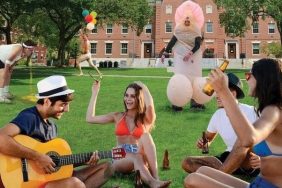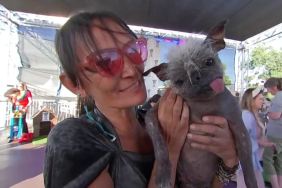Garfield, the comic strip about a lazy, lasagna-eating cat and his melancholy owner, became a cultural milestone in the 1980s. The strip was in practically every newspaper in the country (and still is), merchandise of all shapes and sizes hit the marketplace and cartoon specials starring Garfield became some of the most popular holiday programming on TV.
Those shows, written by Garfield creator Jim Davis himself, are a shared childhood experience for everyone in Generation X and Generation Y, and remain some of the most beloved holiday specials in history, right alongside Peanuts and Rudolph the Red-Nosed Reindeer. And they’re coming to DVD on November, first available exclusively at Wal-Mart, before heading to iTunes and other digital platforms on November 11.
We got Jim Davis on the phone from his home in Indiana to tell us all about how the iconic Garfield Holiday Specials came to be, and to answer the unanswered questions from our childhood. What does the enigmatic ending of the Halloween special really mean? Where did the idea for ghost pirates come from? Does the Davis family really go “Oooooo” every time they turn on the Christmas tree lights?
All this, and the running gag throughout all the holiday specials that no one – except CraveOnline, apparently – ever noticed, are here in our exclusive interview with Garfield creator Jim Davis. We hope you will join us in this trip down nostalgia lane.
CraveOnline: When was the first time someone came to you and said, “Let’s put Garfield on television?”
Jim Davis: Oh, geez… I started the strip in ’78… It was 1980, late ’79 [or] early ’80. Lee Mendelson, a producer in California, called out of the blue, said he had sold CBS the idea of doing a special about the Sunday comics. Garfield was just getting its due, we had published a book, and he wanted him to be animated for the show. I had NO idea how to do that. [Laughs.]
So he introduced me to Bill Melendez, who had been doing the Peanuts specials for years, and then I went out to Hollywood and learned about the process, and helped animate Garfield for an appearance on this “Sunday Funnies” show. It ran, I think it was about 1980-81, in there somewhere. So that was the first experience.
And then we ended up, CBS started doing the specials and we worked with Bill Melendez on those early specials all through the 80s.
Were you concerned about Hollywood getting its hands on your creation? Were you protective of Garfield?
Only for a few minutes, as it turns out. [Laughs.] I was very concerned about who would do the voice, how would he be in animation. Would he move as funny as I had visualized in my head, in what I was creating for the comic strip?
But to be honest, I wrote the first special fully expecting it to be laughed at, and new writers to be brought in, and the producers said, “This is really good. Let’s do this script. [Laughs.] So I actually wrote all the primetime specials, all these specials in the Holiday Collection. I wrote them. I directed the voice tracks. I actually worked here with staff doing storyboards, and even doing layout drawings for the animation. Total control. It was wonderful.
So if there’s anything you don’t like about any of the specials, I’ll have to take the blame for it because we really did have full input on everything and we had great fun doing it too. [Laughs.]
Had you ever written a script before?
No. But being a big fan of animation and the comics, I actually got some books and read up on story structure and things like that. Trying to educate myself as much as possible. Between 25 words or less in a comic strip, or a half hour special, still you have to set up the plot, twist it and resolve it.
So even though there’s a lot of differences between a static comic strip and an animated comic, they’re basically the same. In [some] ways animation is easier because you can let the character go, and you can use effects like music, sound effects and physical timing to help carry a gag, where you don’t have that luxury in a comic strip. So in ways doing the animation was easier.
There’s a recurring gag from the specials that I don’t remember from the comic strips, where Garfield turns to the camera and says, “Nice effect.”
[Laughs.] “Nice touch.”

Oh sorry, “Nice touch.”
Very good! You’re the first person, ever, ever to mention that.
Wow, really? That’s cool.
Seriously. I threw that into virtually every prime time special, just for my own entertainment, because one of Garfield’s appeals, I think, is the way he relates the viewer or to the reader of the comic strip. He knocks down that fourth wall and he talks to the reader.
It occurred to me while I was doing this animation, he’s so into the story and so in character, he never stopped to turn around and say something to the viewers. I thought, well, I don’t want to lose the momentum of the story, I don’t want to distract the viewers just for my own entertainment.
So I thought we’ll do something totally away from the story but a really neat animation effect – lightning on the hold house in the Halloween special, lighting the Christmas tree in the Christmas special, and things like that – and then just having him turn over his shoulder really quickly and go, “Nice touch.” In that way, ha-ha, I can get you right back to the story. So… very observant.
Thank you, I’m a critic. Another thing I noticed is that in the cartoon specials, and also in the TV show in particular, Jon seems a lot less melancholy and depressed. He’s more positive and proactive. Was that a note? Were they concerned about keeping it too downbeat, or did that just drive the story better?
Actually it drives the story a little better because Garfield’s the down guy. It’s the contrast, the conflict where the humor is created. The more down Garfield is, not wanting to go to the farm for Christmas, Jon’s got to be even more up to create that contrast. It’s the old short/tall, skinny/fat, smart/stupid kind of thing to create the conflict, which is necessary for humor. If they all had the same personality it would have no friction whatsoever and therefore nothing to really create humor from, so yeah. The more down Garfield is, the happier Jon gets.

About the Halloween special in particular, where did you come up with the notion of ghost pirates? Were you a big fan of The Fog, or did it come from another place?
[Thinks.] That… is a great question. I don’t know. I just kind of flowed into it. I didn’t want to do a traditional haunted house. Everybody was doing it. “Scooby Doo” was doing it. So I needed to get him away from his normal house, his normal surroundings, that’s why I created the boat going down the river. That kind of separated him from his familiar surroundings and took him on a journey to who knows where.
And the fact that it was going to be pirates returning after a hundred years created a real danger, a real fear of it. To tell him what was going to be scary, that’s why the old guy was there, to set the scene. And really, most of the show is about him telling [Garfield] how scary it was going to be before the ghosts were there. [Laughs.]
Because I thought, so much had been done on TV already, how was I possibly scare anyone? Let’s just tell them how scared they were going to be, and what they imagine is probably going to be scarier than what we could animate.
However, we did do the animation for the pirates here so we get them really flowing, and kind of fun and ephemeral. Back then, because it was actually filmed back then, we did a double burn on that. Basically we overexposed the drawings and that got the glow effect for the ghosts. So we worked very hard to at least get a neat effect.
I can’t say I was a big fan of pirates or anything, but pirates are always fun to do and make funny sounds, and it was a way to dress Garfield up as well.
That old guy gives a great performance. That story scared the crap out of me as a child.
Lindsay Workman was so great to work with, yeah. Great character actor.

I’m curious about the design of that character, because moreso than any other character I’ve seen in your work or spin-offs, he’s a highly detailed character design. Tell me about that.
He couldn’t be the cute, kind of cartoon character you’d normally see even among the other Garfield characters. A guy on staff, Mike Fens, who was a character artist, he [drew] gnarly people, old people, stuff like that for his old stuff.
We were sitting, a half dozen of us, were sitting in our conference room and we’re doing the storyboards and we’re getting to the character sheets before we got really into the storyboards and I explained in great detail what this character had to look like. Everything we were drawing looked like an old guy, a nice-looking cartoon character, stuff like that.
Then Mike came up with something that was totally different from anything we were doing in the strip, with warts and everything like that. I thought, that’s great! Teeth missing and everything. Plus he had to get really close, right down to Garfield’s face. So he had to be really, in order to drive the fact that this was going to be a dangerous situation, he had to be really unpleasant himself. So yeah, it was one of the artists on our staff who created that look to the character.
The Halloween special has a couple of enigmatic aspects to the ending. The old man disappears, and he shows up again on the TV. Did that all that make sense in your head or were you just trying to leave the audience uncertain?
Because of the separation of the haunted house and everything that happened, I wanted Garfield to kind of wonder if it really did happen, or if it was a dream. It was a way of kind of saying, because it was such a departure from the other Garfield shows, it was so strange, I thought, well, we’ll kind of leave it where maybe it didn’t happen. Maybe he imagined it or something like that. And then have it come back.
In fact, obviously the old guy disappeared earlier. Maybe he was one of the pirate ghosts. Maybe he didn’t really exist at all. Maybe they were seeing an apparition. So I left that piece of doubt in your mind, and then in the end, did he really dream that? I really don’t see that, oh, it’s just a nightmare, and then to have the TV show come on, showing this guy again… okay… leaving it up to the viewer what to believe. Maybe they did go to a haunted mansion. Maybe he did dream it.
A lot of times if you leave it up to the viewer it’s going to be a lot more fun to think about. I didn’t really make a statement one way or the other. In fact a lot of time it’s more fun to have two characters, each with distinct points of view, [and] let them hash it out during a show and never draw a conclusion or have an opinion right to the end. That way both sides get to believe what they want to believe and really enjoy the show better.

The Garfield Christmas special was a perennial in our household, and it led to a tradition of our own where every time we turned on the Christmas lights on the tree, we all had to stand around as a family and go, “Ooooooooo…”
[Laughs.] “Oooooooo…!”
Or else it wasn’t Christmas.
Actually we do too! [Laughs.] I made that up. It cracked us up and we did it for the Christmas special, and ever since then we do the very same thing. THAT’s funny.
I’m glad we’re on the same wavelength.
That was actually my family Christmas. That’s Mom, Dad, Doc Boy my brother. In fact I can see his house right across the meadow here. Mom and Dad still live down the street.
Now, I invented Grandma, because I wanted to bring back some of the nostalgia of Christmas. Because I know Christmas means different things to different people, and a lot of times you think about the people you’ve loved in years past. So I wanted to put the sentimental element in there to go from the laughter side to the tears side and bring it back to the wonderful feeling of family. Because I knew I only had one Christmas special I was ever going to get to do, so I really tried to stuff it all in there.
Have they ever, afterwards, offered you another Christmas special?
No. Actually I had done another one for the Garfield show, but it was not the sentimental home kind of thing. Garfield and other animals, stuff like that. It was great fun but not the same kind of charm or family kind of feel that this one has.

It seems like the idea of the holiday special had really diminished of late. What was it like when they were de rigueur? It seems like they were everywhere in the 80s. We had a “Coneheads” holiday special and a “B.C.” holiday special…
[Laughs.] That’s true. We had a 35 share. A third of America watched that special because there were only three networks back then. So it was really a big deal. And then too, I don’t think people went out as much. I don’t think there were as many distractions. There wasn’t an online or anything like that. So that’s what the family got together and watched together. It was a very big deal.
In fact, when we took it to video and then eventually DVD, we had worked it so hard and got so close to deadline, there were a couple of three scenes that were a little bit rough. We actually re-animated parts of the special before it went to video. What you see on the DVD is not what originally aired as such, but we went back and reworked about 4-5 minutes of the show to clean it up and get the timing a little better and smooth it out.
Are we talking about the Christmas special, that you had you touch up?
Mm-hmm. The Christmas special.
Garfield has been going for many decades now and it doesn’t seem like there’s any chance of it stopping anytime soon, but in the back of your head, do you have a final strip in mind? Is there a conclusion?
[Thinks.] No. I have no plans of retiring from the strip because it’s the most fun thing I do, and it’s not a full-time job. That’s the one thing I really love to do. I’ll probably, one day, when I’m not as funny, someone will tap me on the shoulder and go, “Jim, you’re not FUNNY anymore.” I’ll consider turning it over and doing something with it at that point in time.
For five years I did a strip called Gnorm Gnat, when I was trying to get syndicated. When I finally gave up on the idea of bugs… I ran it in a weekly newspaper for five years. The last strip there, a foot came out of the sky and stomped them flat. [Laughs.] That effectively ended that strip. There was only one letter to the editor saying, “Gee, we really miss this strip.” I guess that Gnorm died for good reasons.
Nope, I’m going to keep doing this for as long as I can.
William Bibbiani is the editor of CraveOnline’s Film Channel and the host of The B-Movies Podcast and The Blue Movies Podcast. Follow him on Twitter at @WilliamBibbiani.






